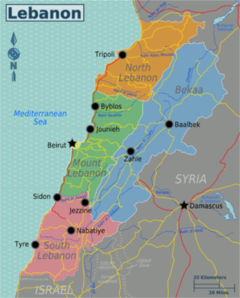Israeli–Lebanese conflict
(Bombing, War, Genocide, Perpetual war, Strategy of tension, Proxy war) | |
|---|---|
 | |
| Type | War |
The Israeli–Lebanese conflict is a series of military clashes involving Israel and Lebanon-based paramilitary groups. In response to Palestinian attacks from Lebanon, Israel invaded in 1978 and again in 1982. After this it occupied southern Lebanon until 2000, while fighting a guerrilla conflict against Shia Muslim paramilitaries. After Israel's withdrawal, Hezbollah attacks sparked the 2006 Lebanon War.
A new period of conflict began in 2023 following the 2023-2024 Israel-Hamas War which started on 7 October 2023. Exchange of strikes between Israel and Hezbollah have been occurring along the Israel–Lebanon border and in Syria and the Israeli-occupied Golan Heights since 8 October 2023. It is currently the largest escalation of the Israeli–Lebanese conflict to have occurred since the 2006 Lebanon War, and part of the spillover of the Israel–Hamas war.
On 8 October 2023, Hezbollah started firing guided rockets and artillery shells at Israeli positions in the occupied Shebaa Farms, which it said was in solidarity with Palestinians following the Hamas attack on Israel that took place a day earlier. Israel retaliated by launching drone strikes and artillery shells at Hezbollah positions near Lebanon's boundary with the Israeli-occupied Golan Heights.
In northern Israel, the ongoing conflict has forced approximately 96,000 individuals to leave their homes, while in Lebanon, approximately 500,000 individuals have been displaced, with Hezbollah saying it would not stop attacks against Israel until it stops its attacks and military operations in Gaza.[1] Between 21 October 2023 and 20 February 2024 the United Nations Interim Force in Lebanon (UNIFIL) recorded an estimated 7,948 incidents of artillery fire from the south of the Blue Line (from Israel to Lebanon) and 978 incidents of artillery fire from the north side (from Lebanon to Israel).[2]
Significant escalation occurred in September, starting with the 2024 Lebanon pager explosions—which targeted Hezbollah and were widely attributed to the Israeli Mossad—and followed by daily Israeli airstrikes that included assassination of senior Hezbollah commanders. Israel stated that its attacks would continue until Israeli citizens in near the northern border could return home safely. The deadliest and most widespread casualties in Lebanon resulted from Israeli airstrikes on 23 September that resulted in at least 558 deaths and more than 1,835 injuries including children, women and paramedics. During this campaign, IDF forces claimed to have bombed and destroyed Hezbollah’s central command headquarters in Beirut. It was not immediately clear if Hassan Nasrallah, leader of the paramilitary group, survived the attack. The IDF later confirmed that it had "terminated" Nasrallah in the strike.[3]
Related Documents
| Title | Type | Publication date | Author(s) | Description |
|---|---|---|---|---|
| Document:Simply No Red Lines At All | blog post | 11 October 2024 | Craig Murray | I am simply unable to begin to understand, on a personal basis, the politicians who can condone, support and in fact participate in what Israel is doing. It is simply beyond me. Every time I worry that public interest is faltering and people have become inured to genocide, the Israelis manage to do soemthing still more outrageous. Thankfully social media makes it very hard to hide this. |
| Document:The BBC is weaponising its Lebanon reporting to help disguise Israel's crimes | Article | 27 September 2024 | Jonathan Cook | By the third week of September, Israel had killed more than 750 Lebanese, compared to 33 Israeli deaths. The differential is even starker now. And yet the western media has not framed Hezbollah’s attacks as its "right to defend itself" – a right we are continuously reminded Israel has. |
References
Wikipedia is not affiliated with Wikispooks. Original page source here